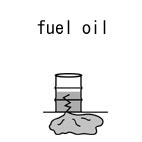| Case Name |
Fuel oil leakage from the corroded part of branch piping for pressure gauge attachment at jetty loading equipment |
| Pictograph |

|
| Date |
July 7, 1993 |
| Place |
Kawasaki, Kanagawa, Japan |
| Location |
Refinery |
| Overview |
When loading of fuel oil was started to tankers at the oil refinery on July 7th, 1983, fuel oil leaked from a corroded part of branched piping for a pressure gauge, and about 2 L leaked into the sea. The cause of the leakage seemed to be inadequate surface treating of painting where rust remained, and advanced corrosion by sea water splashing. |
| Incident |
Fuel oil leaked from piping of marine loading equipment of an oil refinery into the sea. Loading of fuel oil to the tanker started at 0.42 MPaG pressure at the end of loading piping. A crew of the tanker found the fuel oil dropping from the corroded part of branch piping for mounting a pressure gauge about one hour after loading started. It was speculated that about 2 L leaked into the sea. |
| Processing |
Manufacture |
| Individual Process |
Transfer |
| Substance |
Fuel oil |
| Type of Accident |
Leakage |
| Sequence |
From 11:15 to 12:00 on July 7th, 1993; 200 kL of fuel oil was loaded without any trouble using the piping in which a leak occurred later.
13:10; Loading of 280 kL of fuel oil into another tanker started at 0.42 MPaG pressure at the end of loading piping.
14:25; When 240 kL of fuel oil was loaded, a crew of the tanker found a leakage near the pressure gauge mounting part. He informed a person in charge at the jetty. The leak was stopped by an emergency shutdown.
14:30; Recovery of oil was started with oil fences and adsorption mats.
14:35; Setting oil fences was completed.
15:35; Recovery of oil was completed using 100 adsorption mats.
15:45; Surfactant spraying to treat the oil started.
17:00; Surfactant spraying was finished and treatment was completed.
17:33; The accident was reported to the fire department by telephone. |
| Cause |
The branch piping for mounting a pressure gauge was installed in 1973. Afterwards, it was not replaced although external corrosion was advancing due to splashes of sea water. The branch piping was checked by removing paint. On re-painting after the check, surface treating such as rust removal before painting was inadequate. For this reason, corrosion advanced and it seems that a lump of rust peeled off by pressure at the time of loading, and a hole opened. |
| Response |
Loading fuel oil was stopped urgently. Oil fences and adsorption mats were used to recover leaked oil. |
| Countermeasures |
Visual checks were strengthened. When there is any doubt, paint and rust are removed from the full length of the nozzle part, and thickness in a few directions is measured.
All employees were retrained on the necessity to report abnormalities.
Checks of all small piping of the jetty were carried out. As a result, the same defect was found at 18 out of 429 places found. The bad piping was replaced. |
| Knowledge Comment |
External corrosion is easily generated at a specific part. We know those places. For example, the inside of thermal insulation, where trapped water can hardly come out, and the places with poor surface treatment on painting. |
| Background |
Management or specifications of paint work was inadequate.
In 1993, when the accident occurred, external corrosion of piping had already become a topic of maintenance.
Why did the external corrosion of branch piping near the seashore remain? Due to a discrepancy in information-gathering, the preservation plan may have been too late. |
| Incidental Discussion |
As corrosion of piping advances to the inside of piping unexpectedly, preservation repair work might require much time and man-power. Planned and detailed checks are important. |
| Reason for Adding to DB |
Example of leakage caused due to external corrosion of small piping near the coast |
| Scenario |
| Primary Scenario
|
Poor Value Perception, Poor Safety Awareness, Inadequate Risk Recognition, Carelessness, Insufficient Precaution, Work Supervisor Carelessness, Planning and Design, Poor Planning, Poor Planning of Repair, Usage, Maintenance/Repair, Insufficient Surface Treatment, Failure, Abrasion, Corrosion, Secondary Damage, External Damage, Leakage, Secondary Damage, Damage to Environment, Sea Pollution
|
|
| Sources |
High Pressure Gas Safety Inst. of Japan, High-pressure gas protection overview, pp.262-263 (1995).
Kawasaki City Fire fighting station, Prevention division. Peace section, M petroleum Co., Ltd. No.2 jetty shipping facility of transfer office, Material of the Kawasaki City Complex safety countermeasures committee.
|
| Consequences |
About 2 L of fuel oil leaked into the sea. |
| Field |
Chemicals and Plants
|
| Author |
ITAGAKI, Haruhiko (Japan National Institute of Occupational Safety and Health)
TAMURA, Masamitsu (Center for Risk Management and Safety Sciences, Yokohama National University)
|